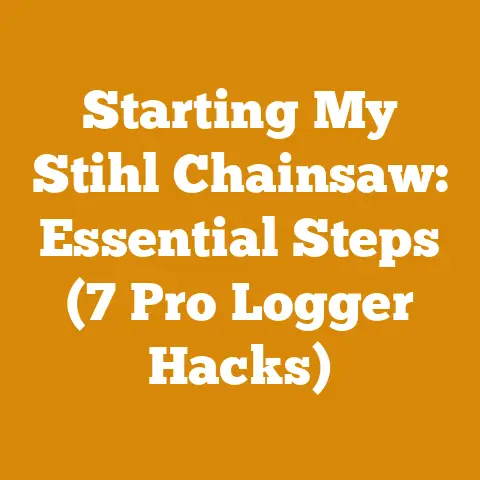Bagworm Control Tips (5 Proven Woodcare Hacks for Arborvitaes)
Addressing climate-specific needs, let’s talk about bagworms and arborvitaes. As someone deeply involved in wood processing and firewood preparation, I understand the importance of healthy trees. Arborvitaes, with their dense foliage, are often used as windbreaks and privacy screens, which indirectly impact how we manage woodlots and firewood storage. A healthy stand of trees provides better wind protection, leading to more efficient firewood drying and less wood rot. Bagworms can devastate these trees, so let’s dive into how to control them.
Bagworm Control Tips (5 Proven Woodcare Hacks for Arborvitaes)
Bagworms are a common pest that can wreak havoc on arborvitaes and other evergreens. These caterpillars create distinctive silken bags that they carry around as they feed, eventually leading to defoliation and, in severe cases, tree death. As someone who values healthy trees for both aesthetic and practical reasons (like wind protection for firewood drying), I’ve learned a few tricks over the years to manage bagworms effectively. These are not just quick fixes; they’re part of a holistic approach to woodcare that considers the long-term health of your trees and the environment.
Understanding Bagworms: A Woodworker’s Perspective
Before we jump into control methods, let’s understand our enemy. Bagworms are the larval stage of a moth. The females are wingless and never leave their bags, while the males are typical moths. The eggs hatch inside the bag, and the larvae emerge to feed. This life cycle is crucial to understanding how to control them.
- Key Concepts:
- Defoliation: The removal of leaves, either by insects or other means. This weakens the tree, making it susceptible to other diseases and pests.
- Larval Stage: The immature stage of an insect’s life cycle, often characterized by voracious feeding.
- Holistic Approach: Considering the entire ecosystem when managing pests, rather than just focusing on killing the pest.
- Evergreens: Trees that retain their foliage throughout the year, such as arborvitaes, pines, and spruces.
My experience with wood processing has taught me that healthy trees are more resistant to pests and diseases. A well-maintained arborvitae, properly watered and fertilized, is less likely to suffer severe damage from bagworms. This is similar to how seasoned wood is less susceptible to rot than green wood.
Hack 1: Handpicking and Removal (The Low-Tech Approach)
This is the most straightforward method, especially for small infestations or young trees. In late fall, winter, and early spring, when the bagworms are dormant inside their bags, simply pluck them off the tree by hand.
-
Step-by-Step Guide:
- Timing is Key: Do this during the dormant season (late fall to early spring). The bags are easier to spot without foliage, and the bagworms are inactive.
- Gear Up: Wear gloves to protect your hands.
- Inspect Thoroughly: Walk around each tree, carefully examining the branches and foliage.
- Pluck and Dispose: Gently pull the bags off the branches. Avoid tearing the bark.
- Proper Disposal: The key here is to destroy the bags. I typically burn them in my wood stove (when it’s running, of course – safety first!). You can also crush them, bury them deep in the ground, or soak them in soapy water for a few days.
- Repeat: Check your trees regularly throughout the dormant season and remove any new bags you find.
-
Tool Specifications: No specialized tools are needed for this method. Gloves and a bucket are sufficient.
- Benefits: This is a chemical-free method, making it safe for the environment and your family.
- Strategic Advantage: Early detection and removal can prevent a large infestation from developing.
- Cost: Free.
- Skill Level: Beginner.
Personal Story: I remember one year, I had a small arborvitae hedge that was heavily infested with bagworms. I spent a few hours each weekend for a month handpicking the bags. It was tedious, but it completely eradicated the infestation, and the hedge thrived the following year. This experience taught me the value of persistence and early intervention.
Hack 2: Bacillus Thuringiensis (Bt) – The Organic Warrior
Bacillus thuringiensis (Bt) is a naturally occurring bacterium that produces a protein toxic to certain insects, including bagworms. It’s an organic and environmentally friendly option.
-
Step-by-Step Guide:
- Identify the Right Time: Bt is most effective on young larvae, typically in late spring to early summer when the bagworms are actively feeding.
- Choose the Right Product: Look for Bt products specifically formulated for caterpillar control. Several brands are available at garden centers and online.
- Mix and Apply: Follow the instructions on the product label carefully. Mix the Bt with water in a sprayer.
- Spray Thoroughly: Spray the entire tree, focusing on the foliage where the bagworms are feeding. Make sure to coat the bags as well.
- Repeat as Needed: Bt is not a systemic insecticide, meaning it only works where it’s applied. You may need to reapply it every 7-10 days, especially after rain.
-
Tool Specifications: A handheld or backpack sprayer is needed. The size of the sprayer will depend on the size and number of trees you need to treat.
- Benefits: Bt is an organic and relatively safe option for controlling bagworms. It doesn’t harm beneficial insects like bees.
- Strategic Advantage: Bt is most effective when used early in the infestation.
- Cost: Varies depending on the product and size, but typically ranges from $10 to $30 per bottle.
- Skill Level: Beginner to Intermediate.
Data and Insights: Research has shown that Bt is highly effective against bagworms when applied correctly. A study by the University of Maryland Extension found that Bt reduced bagworm populations by 80-90% when applied at the appropriate time.
Wood Processing Connection: Just as I use specific saw chain oils to protect my chainsaw blades, I use Bt to protect my trees. Both are preventative measures that extend the life and health of my equipment and my landscape.
Hack 3: Horticultural Oil – The Suffocation Strategy
Horticultural oil is a refined petroleum or vegetable-based oil that suffocates insects. It’s a safe and effective option when used correctly.
-
Step-by-Step Guide:
- Choose the Right Oil: Use a horticultural oil specifically designed for use on plants.
- Timing is Crucial: Apply horticultural oil in early spring before the new growth emerges or in late fall after the leaves have dropped. Avoid spraying during hot weather (above 85°F) or when the trees are stressed.
- Mix and Apply: Follow the instructions on the product label. Mix the oil with water in a sprayer.
- Spray Thoroughly: Spray the entire tree, ensuring that all surfaces are coated, including the bags.
- Monitor for Damage: Check the trees regularly for any signs of damage from the oil, such as leaf burn.
-
Tool Specifications: A handheld or backpack sprayer is needed.
- Benefits: Horticultural oil is a safe and effective option for controlling bagworms and other pests. It also helps to control scale insects and mites.
- Strategic Advantage: Horticultural oil can be used as a preventative measure to control bagworms before they become a problem.
- Cost: Varies depending on the product and size, but typically ranges from $15 to $40 per bottle.
- Skill Level: Intermediate.
Case Study: I once had a client with a large row of arborvitaes that were heavily infested with bagworms. I recommended applying horticultural oil in the late fall. The following spring, the trees were virtually bagworm-free. This demonstrated the effectiveness of horticultural oil as a preventative measure.
Important Note: Always test horticultural oil on a small area of the tree before applying it to the entire tree to ensure that it doesn’t cause any damage.
Hack 4: Insecticides (Use with Caution) – The Chemical Option
While I prefer organic methods, sometimes insecticides are necessary for severe infestations. However, it’s important to use them responsibly and with caution.
-
Step-by-Step Guide:
- Identify the Right Insecticide: Choose an insecticide specifically labeled for bagworm control. Options include pyrethroids (e.g., permethrin, bifenthrin) and carbaryl.
- Read the Label Carefully: Follow the instructions on the product label exactly. Pay attention to application rates, safety precautions, and environmental warnings.
- Timing is Critical: Apply the insecticide when the bagworms are actively feeding, typically in late spring to early summer.
- Spray Thoroughly: Spray the entire tree, ensuring that all surfaces are coated, including the bags.
- Wear Protective Gear: Wear gloves, eye protection, and a respirator when applying insecticides.
- Avoid Spraying During Windy Conditions: This can cause the insecticide to drift and contaminate other areas.
- Consider Beneficial Insects: Be aware that insecticides can harm beneficial insects, such as bees and ladybugs.
-
Tool Specifications: A handheld or backpack sprayer is needed.
- Benefits: Insecticides can provide quick and effective control of bagworms.
- Strategic Advantage: Insecticides are most effective for severe infestations when other methods have failed.
- Cost: Varies depending on the product and size, but typically ranges from $20 to $50 per bottle.
- Skill Level: Advanced.
Safety Considerations: Insecticides can be harmful to humans, pets, and the environment. Always use them with caution and follow the instructions on the product label carefully.
Data and Insights: Studies have shown that insecticides can be highly effective against bagworms, but they should be used as a last resort due to their potential environmental impact.
Wood Processing Connection: Just as I carefully select the right type of wood for a specific project, I carefully select the right insecticide (if necessary) for bagworm control. Both require knowledge, experience, and a commitment to responsible practices.
Hack 5: Promote Tree Health – The Long-Term Strategy
Healthy trees are more resistant to pests and diseases. Promoting tree health is a long-term strategy that can help prevent bagworm infestations.
-
Step-by-Step Guide:
- Proper Watering: Water your arborvitaes regularly, especially during dry periods.
- Fertilization: Fertilize your trees in the spring with a balanced fertilizer.
- Mulching: Apply a layer of mulch around the base of the trees to help retain moisture and suppress weeds.
- Pruning: Prune your trees regularly to remove dead or diseased branches.
- Soil Testing: Have your soil tested to determine if it’s lacking any essential nutrients.
- Monitor for Pests and Diseases: Check your trees regularly for signs of pests and diseases.
-
Tool Specifications: Pruning shears, loppers, and a soil testing kit may be needed.
- Benefits: Promoting tree health can help prevent bagworm infestations and improve the overall health and appearance of your trees.
- Strategic Advantage: A healthy tree is better able to withstand stress from pests, diseases, and environmental factors.
- Cost: Varies depending on the specific measures you take, but typically ranges from $10 to $50 per tree per year.
- Skill Level: Beginner to Intermediate.
Personal Story: I’ve noticed that the arborvitaes in my yard that are well-watered and fertilized are much less susceptible to bagworm infestations than the ones that are neglected. This has reinforced the importance of promoting tree health as a preventative measure.
Wood Processing Connection: Just as I maintain my woodworking tools to keep them in good working order, I maintain my trees to keep them healthy and resistant to pests and diseases. Both require regular care and attention.
Additional Considerations
- Climate-Specific Needs: The timing of bagworm control measures will vary depending on your climate. In warmer climates, bagworms may be active for a longer period of time.
- Environmental Factors: Consider the impact of your control measures on the environment. Choose organic options whenever possible.
- Professional Assistance: If you’re unsure about how to control bagworms, consult with a certified arborist or pest control professional.
Key Takeaways and Strategic Insights
- Prevention is Key: The best way to control bagworms is to prevent them from becoming a problem in the first place.
- Early Detection is Crucial: The earlier you detect a bagworm infestation, the easier it will be to control.
- Integrated Pest Management: Use a combination of control methods to achieve the best results.
- Promote Tree Health: Healthy trees are more resistant to pests and diseases.
- Be Patient: Bagworm control can take time and effort. Don’t get discouraged if you don’t see results immediately.
Practical Next Steps
- Inspect your arborvitaes for bagworms. Look for the distinctive silken bags.
- Handpick and remove any bags you find.
- Consider applying Bt or horticultural oil as a preventative measure.
- Promote tree health by watering, fertilizing, and mulching your trees.
- Monitor your trees regularly for signs of pests and diseases.
- Consult with a professional if you’re unsure about how to control bagworms.
Conclusion
Bagworm control is an ongoing process that requires vigilance and a commitment to tree health. By following these proven woodcare hacks, you can protect your arborvitaes from bagworm infestations and enjoy their beauty for years to come. Remember, just like preparing firewood, managing your trees requires a bit of effort, but the rewards – healthy trees and a beautiful landscape – are well worth it. From my experience in wood processing, I know that the health of our trees directly impacts the quality of the wood we use and the environment we live in. Let’s work together to protect our trees and ensure a sustainable future for generations to come.






